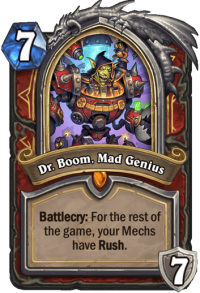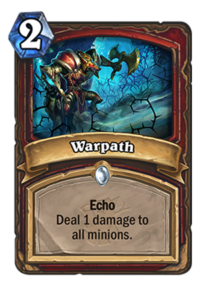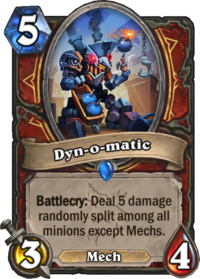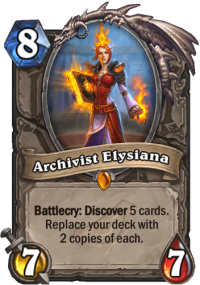Our Control Warrior deck list guide goes through the ins-and-outs of this evergreen Warrior build for the Rise of Shadows expansion! This guide will teach you how to mulligan, pilot, and substitute cards for this archetype!
Introduction to Control Warrior

Control Warrior is as old as Hearthstone: a Hero Power that provides armor and a number of excellent removal cards in the Classic set have kept the archetype relevant throughout the history of the game. The win condition has changed along the way a few times, as sometimes the deck has included big late-game minions and sometimes it has been all about removal and running the opponent out of resources.
Rise of Shadows Control Warrior is quite far at the removal end of the spectrum: Archivist Elysiana ensures that fatigue is not an issue and Dr. Boom, Mad Genius provides a near-endless capability to remove threats. The same cards also provide some potential threats, so while their defensive use is in the spotlight, they can also end games before the turn limit. The rest of the deck is a mixture of general removal tools and tech cards that help the Control Warrior reach these powerful tools against slower decks and exhaust aggressive decks already on the way there.
Control Warrior mirrors are some of the longest games ever in Hearthstone at the moment, and some players have chosen to avoid lengthy mirrors by cutting Archivist Elysiana and putting in Mecha'thun instead. If you find yourself surrounded by Control Warriors, you can give that a try. Nonetheless, the main path of Control Warrior in Rise of Shadows is the path of outlasting the opponent and never suffering from fatigue yourself.
Control Warrior Deck List
This sample deck list is from Old Guardian.
- 0Control Warrior Deck List Guide – Rise of Shadows – May 20191
- 0Control Warrior Deck List Guide – Rise of Shadows – May 20191
- 0Control Warrior Deck List Guide – Rise of Shadows – May 20191
- 0Control Warrior Deck List Guide – Rise of Shadows – May 20191
- 0Control Warrior Deck List Guide – Rise of Shadows – May 20192
- 0Control Warrior Deck List Guide – Rise of Shadows – May 20192
- 0Control Warrior Deck List Guide – Rise of Shadows – May 20192
- 0Control Warrior Deck List Guide – Rise of Shadows – May 20192
- 0Control Warrior Deck List Guide – Rise of Shadows – May 20192
- 1Eternium Rover1

- 1Omega Assembly2

- 2Warpath2

- 2Weapons Project2

- 4Militia Commander2

- 4Omega Devastator2

- 5Supercollider1

- 7Dr. Boom, Mad Genius1

Check out alternative versions of this deck on our Control Warrior archetype page!
Control Warrior Mulligan Strategy & Guide
VS Fast Decks
Higher Priority (Keep every time)
- Town Crier – Early minion that tutors a Rush minion.
- Eternium Rover – Early minion to contest the board and gain armor.
- Militia Commander – Powerful removal minion for the early game.
Lower Priority (Keep only if certain conditions are met)
- Warpath – Keep against token decks: Druid, Hunter, and Warlock.
- Brawl – Keep against token decks: Druid, Hunter, and Warlock.
- Dyn-o-matic – Good minion to clear small tokens. Keep against Druid.
- Dr. Boom, Mad Genius – Many useful Hero Powers against small tokens, keep against Druid.
- Harrison Jones – Keep against Rogue.
VS Slow Decks
Higher Priority (Keep every time)
- Dr. Boom, Mad Genius – Your main value engine, allows you to maintain constant pressure and force the opponent to respond to your plays turn after turn.
- Town Crier – Early minion that tutors a Rush minion.
Lower Priority (Keep only if certain conditions are met)
- Shield Slam – Keep against Mage to deal with an early Mountain Giant. Also keep Shield Block for the same purpose.
Control Warrior Play Strategy
As a Control Warrior, you outlast your opponent. Whether it’s an aggro deck that you can simply run out of resources or a control deck that you are ready to take all the way to the turn limit if needed, you are the unmovable object, the pillar of strength that withstands all attempts to topple you.
VS Aggro Decks

Your main strategy against aggro decks is to run them out of resources. Try to use the appropriate removal piece for each threat and you generally have enough of them so that the opponent will have no way to deal the necessary damage. Playing a control deck requires good knowledge of your opponents, as you need to choose your responses according to what your opponent is capable of. As the meta is constantly changing, any guide can only give you some general guidelines for matchups – you need experience to know which cards you need to answer specific threats in your current meta.
Rogue is the public enemy #1 in Rise of Shadows, but Control Warrior is the best counter to it, so you have a good chance in the matchup. There are several things you need to consider when playing against Rogue:
- Weapon removal plays a key role. You have Weapons Project and Harrison Jones, so you can remove quite a few weapons. Rogue comes at you with Waggle Picks, Deadly Poisons, and Captain Greenskin. When you remove Waggle Pick, Rogue still benefits from the Shadowstep effect, if they have any minions on the board. Furthermore, they have those weapon buffs, so if you remove Waggle Pick with Weapons Project, Rogue can simply buff up the shiny 2/3 weapon you just gave them. Try to bait weapon buffs or have a second weapon removal piece in hand when you take away Waggle Pick. It’s an elaborate dance of who controls where the Shadowstep effect lands and how big of a weapon the Rogue can make.
- Rush minions are good against Rogue. Rogue can usually remove your few minions with ease, but Militia Commander can take out most of their minions, including an extremely favorable value trade on EVIL Miscreant.
- Edwin VanCleef can be scary. Sometimes you can deal with it with a Shield Slam, but often you need Ironbeak Owl or Execute, depending on which one you have included in the deck. Be wary of big Edwin plays.
- It ain’t over ’til it’s over. Rogues can tech in Heistbaron Togwaggle or Chef Nomi, and the boards created by them can challenge you even when Rogue hits fatigue. Be conservative with your use of Brawl, as it can answer those late-game boards. Warpath can be used more liberally to take out the usual pirates.
Another common foe that is interesting to play against is Token Druid. Token Druid can create a lot of boards between Wispering Woods, Soul of the Forest, and The Forest's Aid, so you need to budget your removal accordingly. In general, you want to use Warpath to deal with Soul of the Forest and Brawl to deal with buffed boards without Deathrattles. Dyn-o-matic is excellent against an early Wispering Woods, and you want to turn into Dr. Boom, Mad Genius as soon as possible, because it gives you Hero Powers that are good at dealing with tokens.

Dyn-o-matic is one of your premium removal tools. Count how much non-Mech health there is on the board before committing it, and see if you can get that number to five or below. Remember that Dyn-o-matic does not hit Mech minions! Dyn-o-matic is especially good if you have had time to switch over to Dr. Boom, Mad Genius, because then it will have Rush and it can hit something after the Battlecry effect.
Mech-based Hunter decks are difficult opponents, because they completely neutralize Dyn-o-matic‘s Battlecry effect and force you to rely on your Rush minions and general removal tools. With a list that includes silence, plenty of Rush minions, and Supercollider, you still stand a decent chance.
You are generally looking for opportunities to switch over to Dr. Boom, Mad Genius even against aggro decks, especially board-based ones. The enhanced Hero Power provides several ways to respond to minion threats, and is only weaker than your regular Hero Power against decks that run a lot of burn spells. Dr. Boom, Mad Genius also provides you with a spike of seven armor, which can be important in enabling Shield Slam, which can otherwise be difficult to use at times in the post-Baku world. Shield Block provides a similar sudden boost of armor, and you often need to consider whether to use it early for card draw or save it for later to enable Shield Slam.
You do not need to bounce Archivist Elysiana against aggro decks. In fact, you rarely play it at all in such matchups. Therefore, you can use the bounce effect to get more value from your Battlecry minions – I have sometimes even bounced Town Crier with Youthful Brewmaster against Rogue in order to dig for more Rush minions to keep the board clear. The popularity of these matchups is why I prefer Youthful Brewmaster over Baleful Banker – Brewmaster is much more useful against aggro while still providing the essential bounce against control.
VS Control Decks

Against control decks, you’re in for a long game. With Archivist Elysiana and a bounce effect from either Youthful Brewmaster or Baleful Banker, you can comfortably reach the turn limit. After 45 turns, a game of Hearthstone ends in a draw. You have 30 cards in your deck, and two copies of Archivist Elysiana give you another 20 cards, so you’re essentially playing with a 50-card deck. Even if you draw a little and end up taking a couple of points of fatigue damage in the end, fatigue will not kill you.
So, what can kill another control deck? It’s either the cards you get from Archivist Elysiana or pressure from your never-ending value generator, Dr. Boom, Mad Genius. Just think about it. If you play an early Boom, you will be able to use its Hero Power more than 30 times during a game that goes close to the turn limit.
Therefore, Dr. Boom, Mad Genius is essential for maintaining pressure. You want to switch to that hero as soon as possible in control matchups, because it generates tons of value and a constant stream of minions for you. The only exception is matchups where the opponent has a damage-based win condition. Decks such as Freeze Mage and Holy Wrath Paladin try to kill you with direct damage, and they have plenty, but their supply is not endless. Two big Holy Wraths with Shirvallah, the Tiger is 50 damage, and they can also have Alexstrasza to put you down to 15 health. You can out-armor that, although just barely.
It is important to recognize when you’re actually playing against a combo deck. Perhaps the Warrior you are up against is actually Mecha’thun Warrior and not a pure control build. Unseen Saboteur is a key combo-disruption piece, and with Youthful Brewmaster you can have two tries to force-cast the key spell before it can be used against you. Note that against the main Mecha’thun Warrior OTK combo, you may need to Shield Slam your own Unseen Saboteur if you pull Inner Rage, as otherwise Mecha’thun Warrior can use your minion to kill off their rushing Mecha'thun. Even if you succeed in disrupting the full combo, you still need a silence effect to deal with Mecha'thun, if it is the last minion and the last card.
Control Warrior Card Substitutions
All varieties of Control Warrior are expensive to build, because there are several mandatory Epic and Legendary cards. Even when cards can be replaced, they often weaken the deck significantly.
- Brawl and Dr. Boom, Mad Genius are core Warrior cards that cannot be replaced.
- Archivist Elysiana is a key card for control mirrors. Because Control Warrior does not have a strong proactive win condition, unlike something like Bomb Warrior, you cannot easily replace Elysiana. There are two options: One is Mecha'thun, because then you can try to counter others going infinite by using Mecha'thun as your win condition. You do not need to go for a full combo to use it, either. The other is Azalina Soulthief, which you can use to copy your opponent’s Elysiana combo before they use it. Both are responses to Elysiana, which remains the main option.
- Zilliax is a great Mech minion that synergizes well with everything Warrior wants to do. There are no direct replacements, but it is not strictly mandatory. You can use the slot for another Rush minion or a tech card. Zilliax is the most used card in the game, however, so it should be the first Legendary you craft regardless of what decks you play.
- Town Criers are tutors for Rush minions in the deck. They are not absolutely mandatory, and can be replaced with another Eternium Rover and a draw tool, such as Acolyte of Pain.
- Shield Slams and Omega Devastators are some of your key removal cards. Two of them can be replaced with Executes, but you need at least two of them.
- Darius Crowley is a decent Rush minion, although it is only the fourth in importance in the deck. It can be replaced with another Rush minion, either Rabid Worgen or Amani War Bear, depending on the meta and whether you need the Rush minion early or in the mid-game.
- Harrison Jones is not only a weapon removal tech card, but also a key part of your card draw combo with Weapons Project. It can nonetheless be replaced, either with an Acidic Swamp Ooze if you really need weapon removal, or with another card draw tool, such as Acolyte of Pain or Slam.
- Supercollider is a flexible removal tool. It can be replaced with an Execute or with the classic Epic cards Big Game Hunter or Gorehowl.
- Unseen Saboteur is a tech card against combo decks. There is no good replacement, although you can try Hecklebot for a slim chance to disrupt combos.
Leave a Reply
You must be logged in to post a comment.




Elysianna body disappear … ?????
Yes, it does disappear from the board when you bounce it to your hand (that’s kind of the point of bouncing). But Control mirrors are only a part of the ladder, relatively small compared to all the Tempo Rogues, Conjurer Mages etc. And Banker is only better with Elysiana (still not always, because you risk a random Hecklebot, even if it’s not very common), Bremwaster is better against all the decks where you don’t hit turn timer limit because you shuffled 20 extra cards into your deck. Banker is basically a 2/2 on the board with no extra effect, Brewmaster can be used to bounce your good Battlecry cards / wounded minions / etc. and replay them. Even when just played on T2, 3/2 minion is WAY better than 2/2, since it can contest all the 3 health minions.
Why brewmaster ? Banker is better..
Banker is not better. There is only one instance where Banker gives you any advantage, and that is a control mirror where you can keep Elysiana on the board to create pressure while shuffling another one in the deck. Even then it could backfire, should that second Elysiana be fished out from the deck with Hecklebot, but the opponent is unlikely to risk a Hecklebot when you have five discovered cards in the deck.
In every other case, Brewmaster is better. It allows you to reuse your assets immediately or at the latest on the following turn. Dyn-o-matic, Militia Commander, Town Crier, Unseen Saboteur, whatever you need in the matchup, and in most matchups having access to two turns with one of them is far more important than the endless deck.